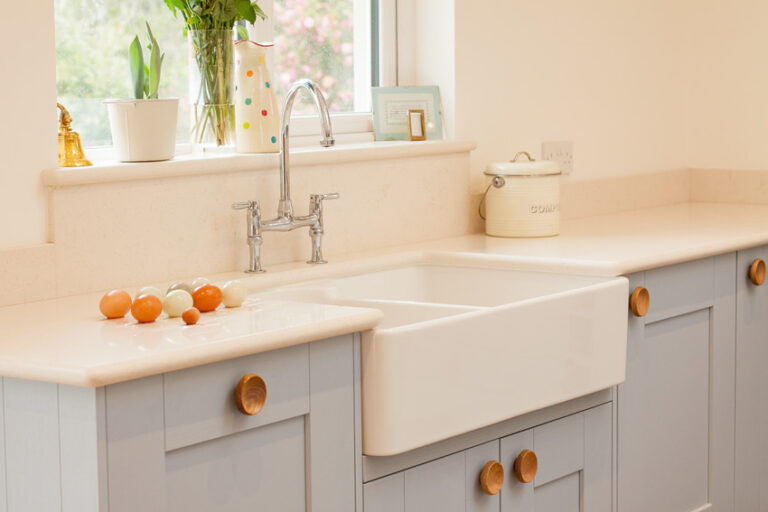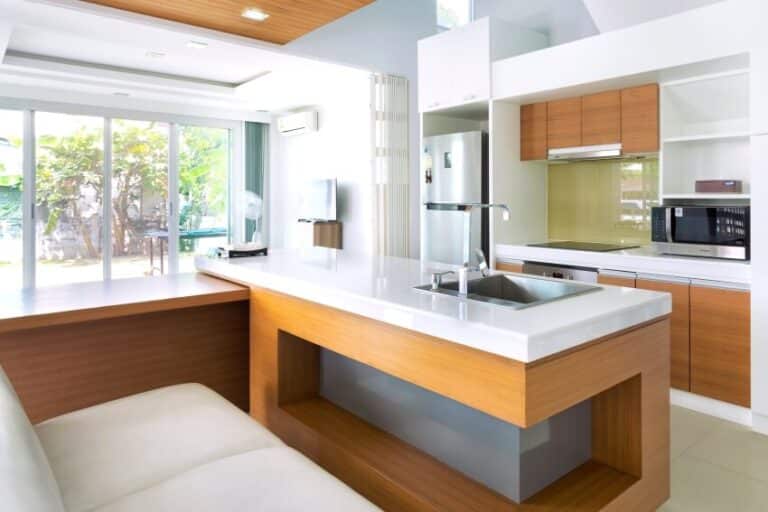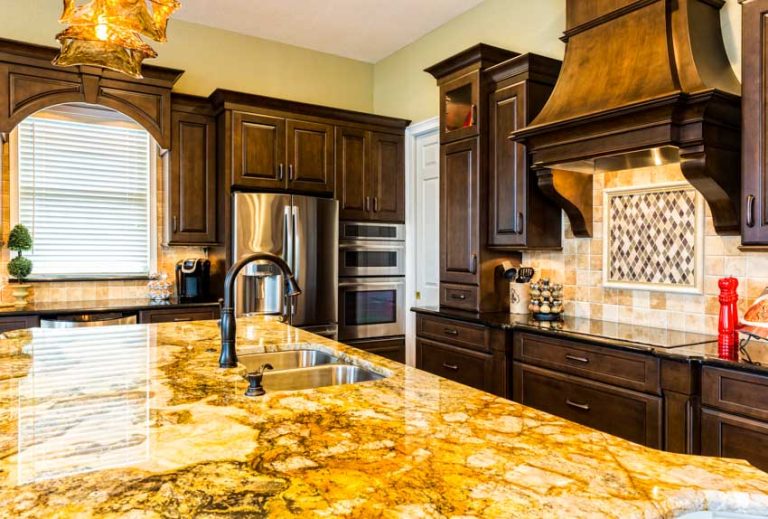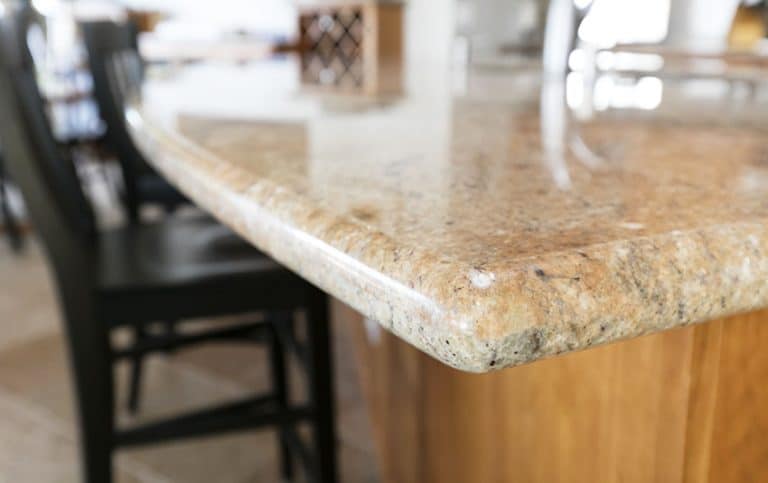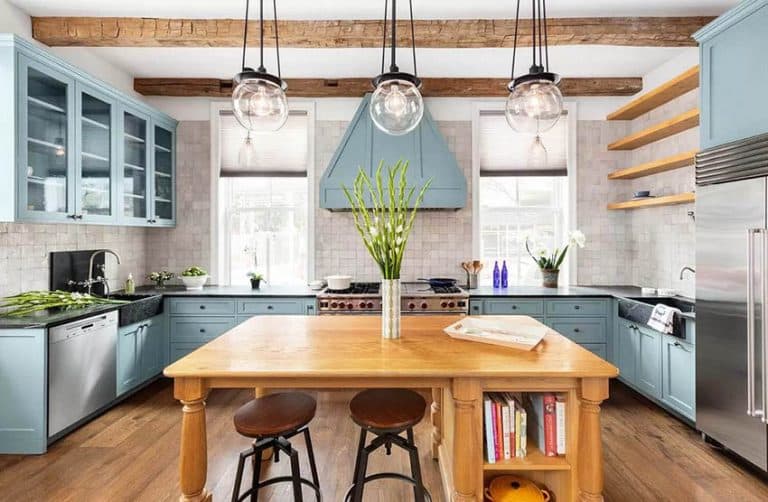Porcelain Backsplash (Types & Buying Guide)
In this porcelain backsplash guide, you’ll discover its benefits, different types, pros and cons, cost, how to paint it, and if porcelain tile backsplash is better than ceramic.
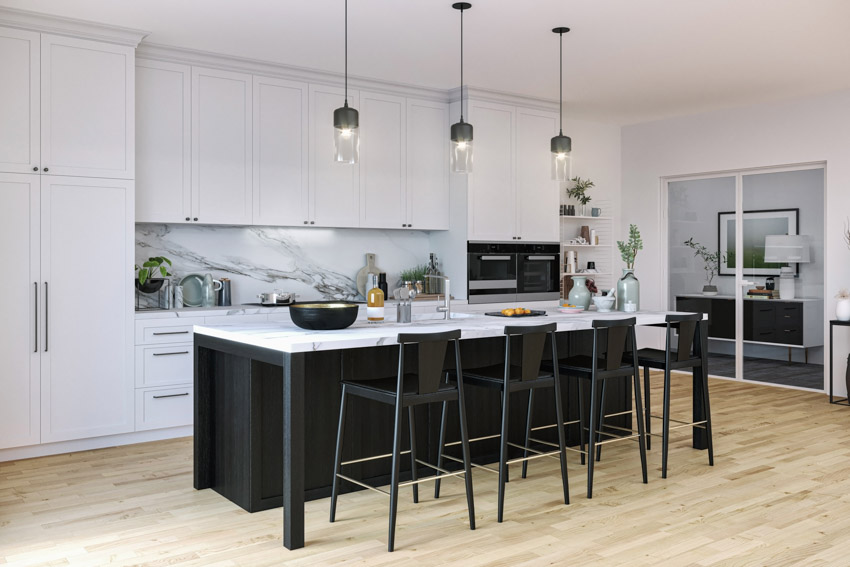
They come out of the kiln being more homogenous, impervious to moisture and other external elements, and denser in general. Their durability and beauty make them an excellent kitchen or bathroom backsplash material.
What is Porcelain Backsplash?
Porcelain has existed for over a thousand years and has been utilized by even the earliest civilizations. It is made from natural clay and has a special process for manufacturing. China has been known to produce porcelain for centuries now, with a very high percentage of the raw material being made from kaolin clay, also nicknamed China clay.
Along with this main clay, porcelain is mixed in with other materials such as feldspar, silica, and different types of mineral oxides that add durability and strength to the finished material. This mixture is then put in a kiln and fired up at very high temperatures.
The result is a backsplash material dense enough to be impervious to water, etching, scratching, chipping, cracking, staining, and even sustaining UV damage. There are instances wherein pigmented glazes are added that help the porcelain slab to produce different colors and patterns.
Benefits of Porcelain Tiles as Backsplashes
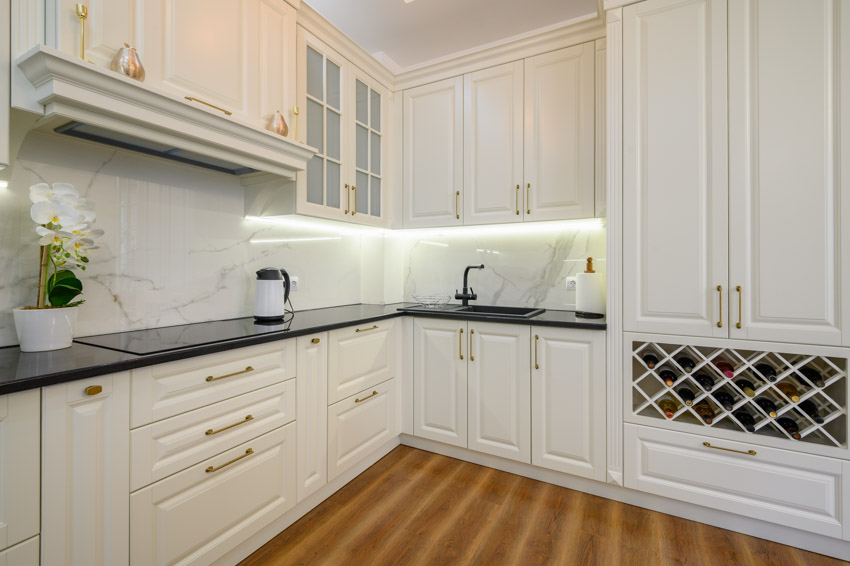
They’re very hygienic and easy to clean: The kitchen needs to be extra clean and hygienic. It’s where your food is prepared, after all.
Unsurprisingly, easy-to-clean surfaces have become a top priority for households worldwide these days. Porcelain tiles are denser and less porous than other surface materials.
This means that they are less likely to manifest damaging effects caused by moisture and other similar elements. This also technically means that porcelain is a type of surface that is deemed uninhabitable by molds and mildew.
When properly grouted, porcelain tiles won’t require much to keep them clean and shiny as new all the time.
They’re very versatile and centered on design: If your goal is to create an eclectic layered space that is a unique representation of your tastes and style, this can be easily accomplished by mixing and matching the materials you use for your backsplashes.
These types of kitchen backsplash are usually at eye level which means that they are the perfect conduits for the mood and color scheme that you would like to have on display.
Thoughtfully curating your mosaic and porcelain tiles will allow you to bring that extra attention to detail and a degree of self-expression to your kitchen space.
You can go with any look and feel you want; whether it’s contemporary, muted, small mosaic tiles, or large format ones. Porcelain can take on any shape, size, and color you may want.
These dynamic design options, along with porcelain’s natural imperviousness to moisture and kitchen grease and stains, make it ideal as a material for kitchen backsplashes that are not only nice to look at but are also durable and easy to maintain at the end of the day.
If you want to go for something dramatic, you can play with contrasts of colors; maybe go for a darker cabinet color to pair up with your muted porcelain tiles.
You can play with the same hues at varying degrees and intensities if you want something more cohesive and monochromatic. You can also add some more variety by playing with finishes, textures, and tones not just with your backsplash tiles but throughout your kitchen space as well.
Types of Porcelain Type Backsplashes
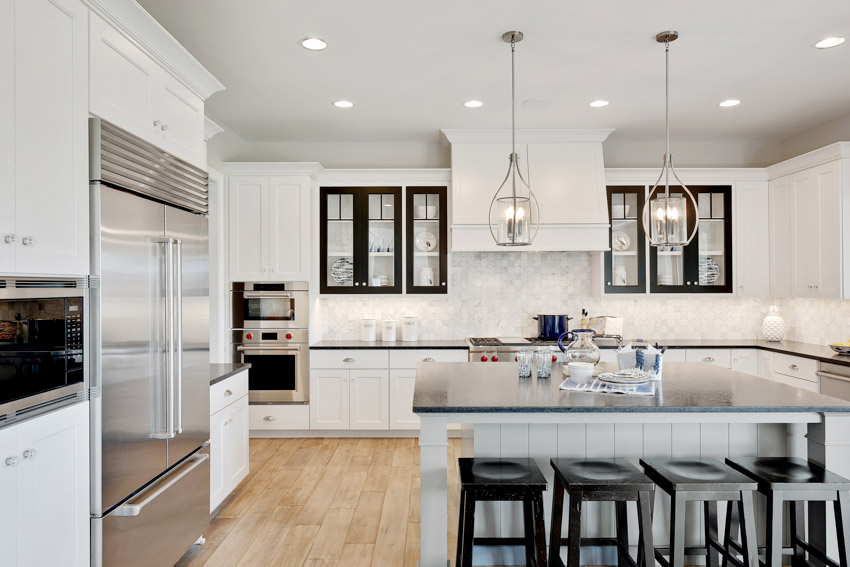
Large Tiles
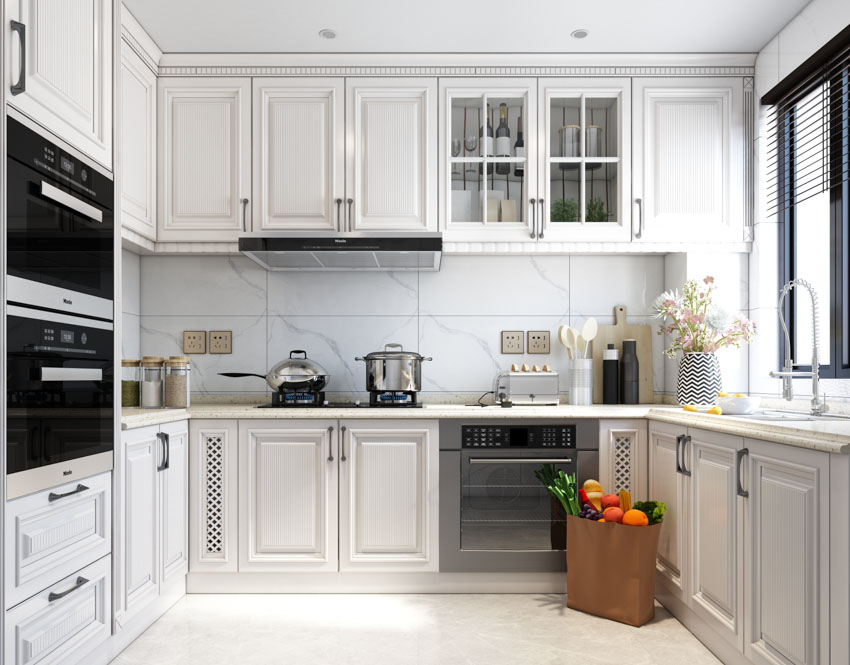
This allows you to replicate the look and feel of granite, marble, or any material you can think of without the inherent maintenance requirements that typically come with the type of natural material it mimics.
These tiles typically come in two standard sizes: 118”x69” and 126”x63”. Both are typically 6mm thick but can come in 12mm thicknesses. It’s a highly durable material that’s uniform throughout and it costs far less than natural stone slabs, too.
Large porcelain tile backsplashes are:
• Low maintenance. They usually require nothing more than a basic wipe-down to keep clean
• Durable and hard
•They can be installed with very minimal grout, making the tile seams and joints virtually imperceptible
• Can be installed quickly on existing surfaces and are less expensive than natural stone
• Dense and nonporous, making them resistant to staining, scratching, and even heat
As great as they are, large tiles made of porcelain can come with certain downsides. For starters, they can be difficult to manufacture due to the mere fact that their colors and patterns are printed on top of the surface and aren’t naturally occurring.
This also leaves them more brittle and more prone to chipping. And although they are virtually scratch-proof, they do have a weakness: ceramic knives. This is the one thing that’s capable enough to scratch through a porcelain surface.
That’s why it’s always recommended to use care when cleaning or positioning kitchen accessories next to porcelain backsplash. If you have a porcelain countertop it is necessary to use a proper cutting board and not cut ingredients directly on your porcelain surfaces. Once scratched, it is very difficult to repair, so you would most likely get it replaced.
Marble Look Type
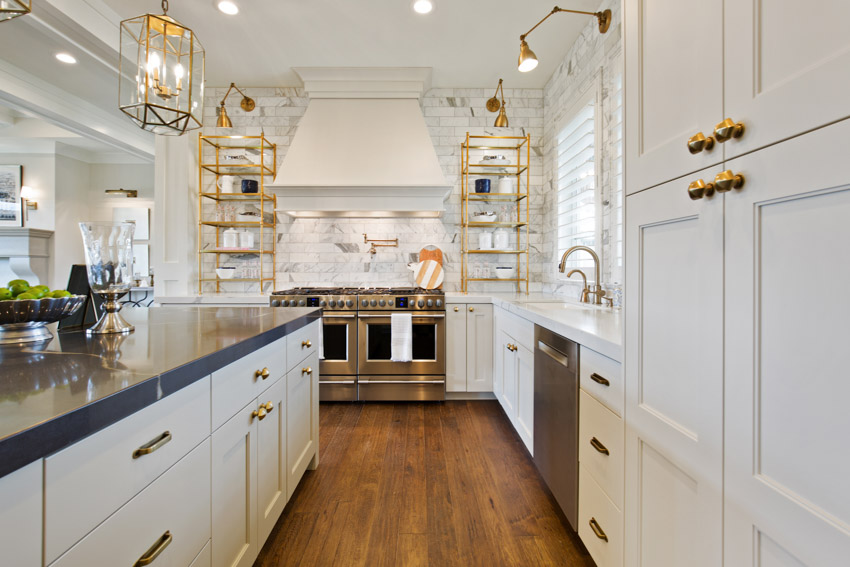
You can still live out your kitchen’s backsplash marble dreams by going for marble-look porcelain tiles. This is a new trend that has been brought about by innovations in technology that make your porcelain tiles look just like natural marble; down to the color gradients, variations, and even the veining.
You’re copping the look of natural marble for less. The porcelain tiles are manufactured in such a way wherein they are meant to look like actual marble. The technology for this has become so advanced that it has become virtually indistinguishable from real marble.
On top of the fact that it costs far less since fired clay is impervious to moisture, it also means that you get the look without the punishing maintenance that usually comes along with natural stones.
Marble is a porous organic material that must be sealed at least twice a year to retain its original beauty. Any spills and damages can leave permanent stains on the surface if unprotected. You don’t have to worry about this with fired clay tiles, as they are resistant to staining and scratching.
Porcelain Brick Backsplash
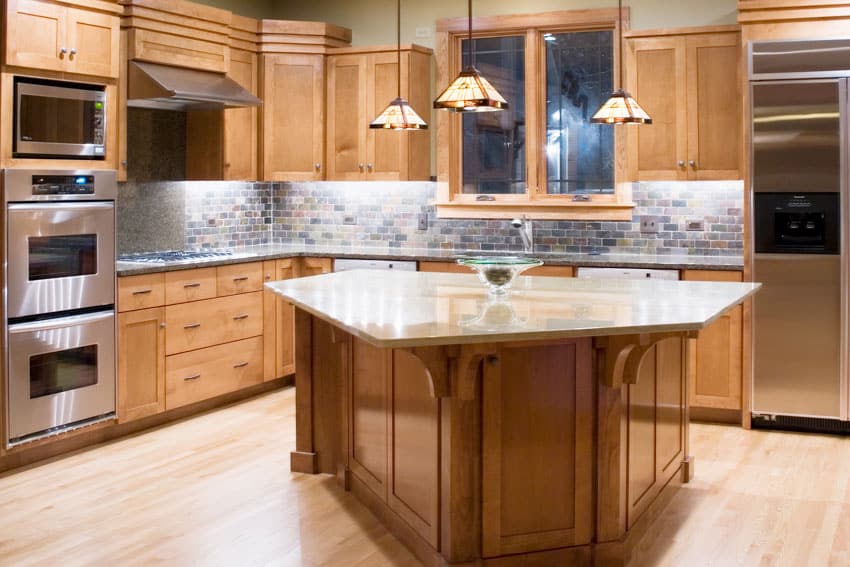
They’re stylish and durable. They are perfect for adding to your kitchen backsplash, whether it’s for an indoor kitchen or an outdoor one, due to their distinct appearance.
Brick-like backsplashes make for killer accent walls. If the kitchen aesthetic you’re going for is something rustic or something that closely resembles a farmhouse aesthetic, then porcelain brick tiles should be the perfect material for your backsplash needs.
These tiles deliver highly realistic-looking brick aesthetics, right down to the color and the texture. It’s a modern twist on a classic and an old-timer favorite that’s renewable, stylish, and also impressively affordable. It can come in mini formats to large format ones. There’s bound to be a perfect one suited for your specific design preferences.
Porcelain Subway Tiles
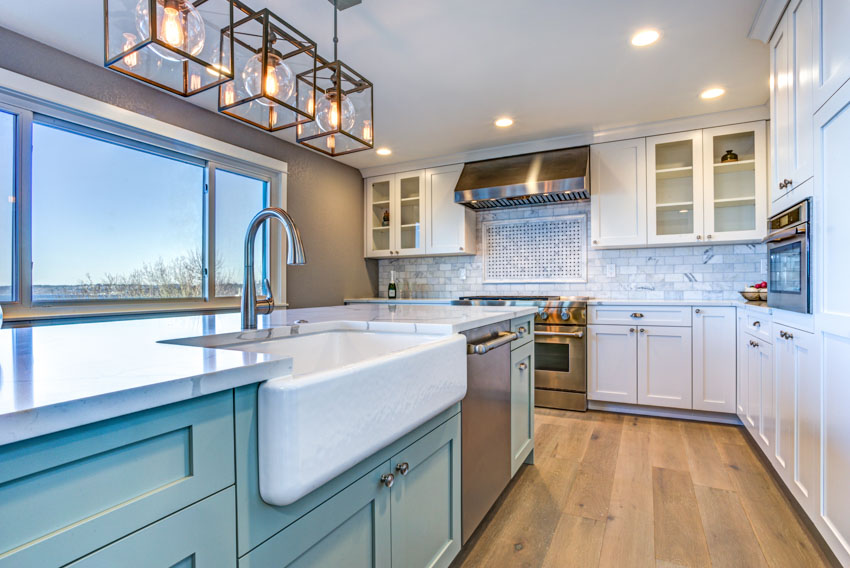
A porcelain subway tile kitchen backsplash can come glazed or unglazed, printed on or plain, and in a wide variety of sizes, shapes, colors, and so much more. The trend for subway tiles is that they are always in high gloss or highly glazed finishes.
This delivers a very posh and modern look that is at the same time classic and timeless. It’s a very unique and difficult combination to achieve, but for some reason, it’s something that porcelain subway tiles can achieve quite easily for your backsplashes in the kitchen space.
There’s a pretty good reason why fired clay subway tiles are popular as backsplashes. They’ve very easy to clean and maintain. They’re surprisingly cheap, and they are, at the same time, endlessly versatile.
Regardless of the look you’re trying to achieve and the current interior design trends, subway tiles have never really been out of vogue; and we’re starting to think they never will be.
Porcelain Mosaic Tiles
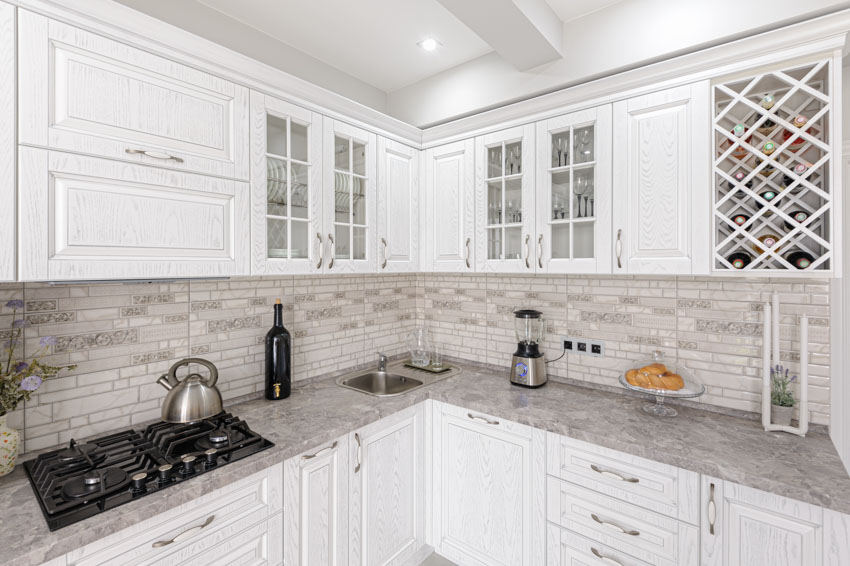
They are functional yet elegant. They are the perfect marriage between aesthetics and functionality – two things that are required to make an excellent kitchen backsplash.
There is a wide variety of porcelain mosaic tiles available, and the options can easily be endless. There are so many colors and design themes to choose from; you are always guaranteed to find something that fits your wants and needs exactly.
There are variegated mosaics if the goal is to shoot for more contemporary themes in the kitchen space. There are dynamic and colorful ones if you want to go for something a little more eccentric and out of the box.
The thing is, there is bound to be a tile shape, pattern, and color that’s exactly to your liking – it’s just a matter of finding the right porcelain mosaic tile in the first place. So be patient. Shop around. And don’t be afraid to play around with tile samples if you have to.
Porcelain Wood Tiles
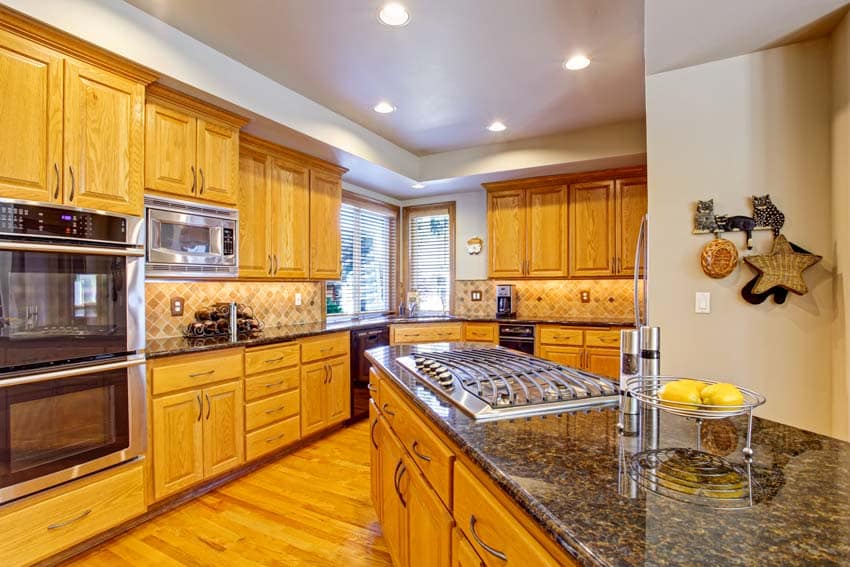
The downside to organic materials though is that they aren’t as durable and long-lasting. The answer? You can have the best of both worlds through porcelain wood tiles.
They provide you with a gorgeous and organic natural look, but at the same time, they are a very high-performing material. They have all of the beauty and charm of natural wood without the obvious disadvantages.
Porcelain wood tiles are resistant to staining, rotting, water damage, UV damage, etc. On top of these obvious advantages, it’s also impressive to note that they are cheaper than actual natural wood.
They fair so much better as kitchen backsplashes, given that they are constantly exposed to moisture, heat, grease and splashes, stains, and so much more. It’s gorgeous and durable and, frankly speaking, so much more sustainable than natural wood.
Wood tile backsplash has a gorgeous, luxurious appeal. They require little to no maintenance at all. And most importantly, you don’t have to worry about having it degrade over the years, given that porcelain is naturally impervious to pretty much anything that wood is susceptible to.
Glazed Porcelain
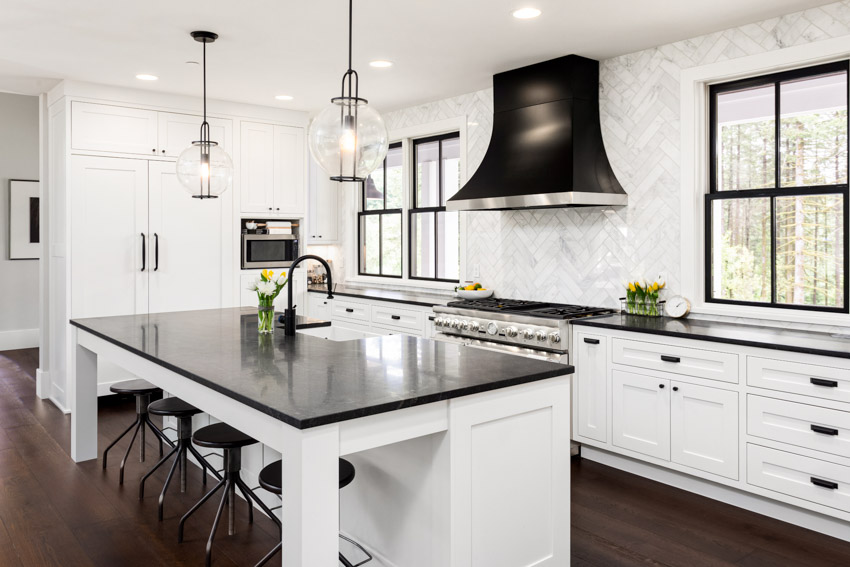
It can be anything from enamel to liquid glass. What makes them ultimately so unique is the higher level of luster they have compared to unglazed fired clay tiles. It’s interesting to note that they are also typically thinner, and they go through extra processes, such as extra firing sessions in the kiln for that extra coating or layer of glaze.
Their colors don’t fade out easily. Most of these tiles are laid indoors anyways so, which further prolongs their life span, but even if laid outdoors, you can rest assured of the fact that they won’t get damaged with prolonged UV exposure. It can endure harsh sunshine, and its colors won’t easily fade out.
It has scratch and stain-proof surfaces. As with most fired clay tiles, glazed ones are also scratch and stain-proof. This scratch-proof quality allows your glazed porcelain tiles to retain their look for much longer. On top of this, because of its highly reflective surface qualities, it also means that should there be stains and scratches, they will not be easily seen on the tile surfaces.
They are easy to clean and maintain. Even if you have the occasional food and grease splatter, it shouldn’t be that much of an issue because you can easily wipe the surface clean with a wet rag and some basic household cleaner.
Peel and Stick Backsplash
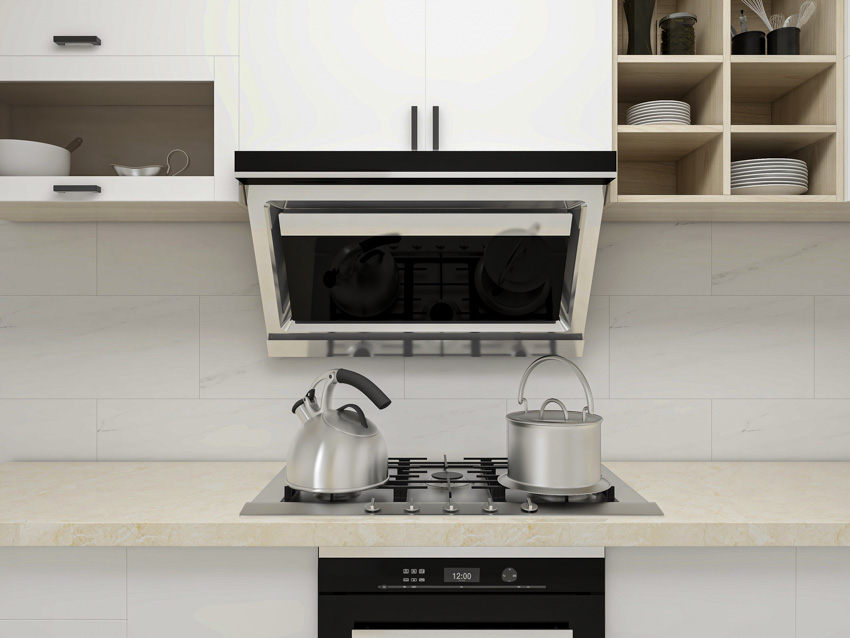
It’s an affordable makeover and something that you can do yourself and instantaneously, even. They don’t require any special tools to install and are typically true to their name.
You peel them off, then stick them to the backsplash area of your choice, and you’re pretty much good to go. This is a great option if you don’t have the commitment and the budget for a full-on tile backsplash.
Here are some of the reasons why a peel and stick tile backsplash option may appeal to you:
• It’s affordable
• It’s convenient
• It’s easy to install
• It can be easily removable, so if you’re renting out or are currently in between homes, it would make sense to opt for it.
• There isn’t any professional installation required for it.
• It does, however, come along with real disadvantages.
• It doesn’t look like a real tile – more like an imitation of it.
• It may have issues with the adhesives, especially when not installed properly.
• It can be messy at times.
• It doesn’t add to the resale value of your home.
Porcelain Slab
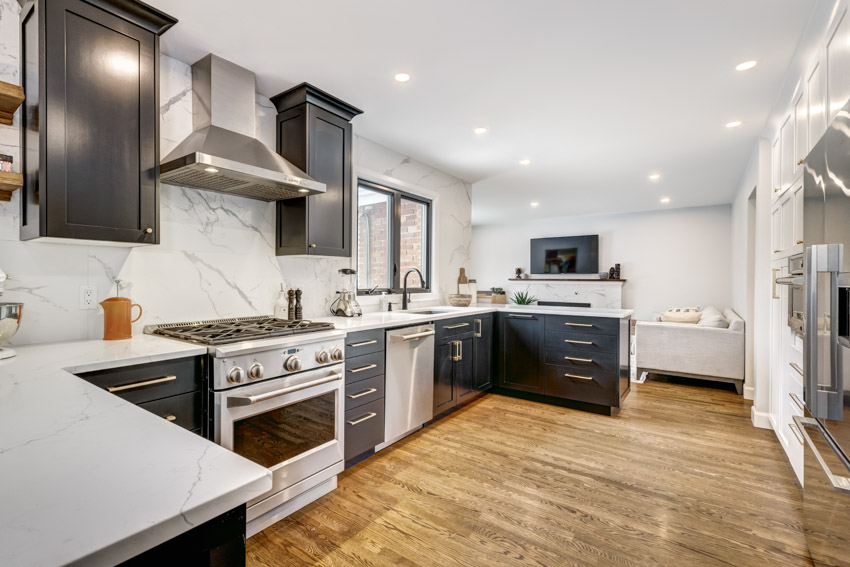
Not only are they affordable, but they also require far less maintenance compared to a real natural stone slab. Honestly speaking, there isn’t anything more you could ask for.
A bookmatched porcelain slab backsplash can mimic the look and feel of natural stone perfectly, and it comes as no surprise why they have become so increasingly popular over the years.
Porcelain Marble Look Slab
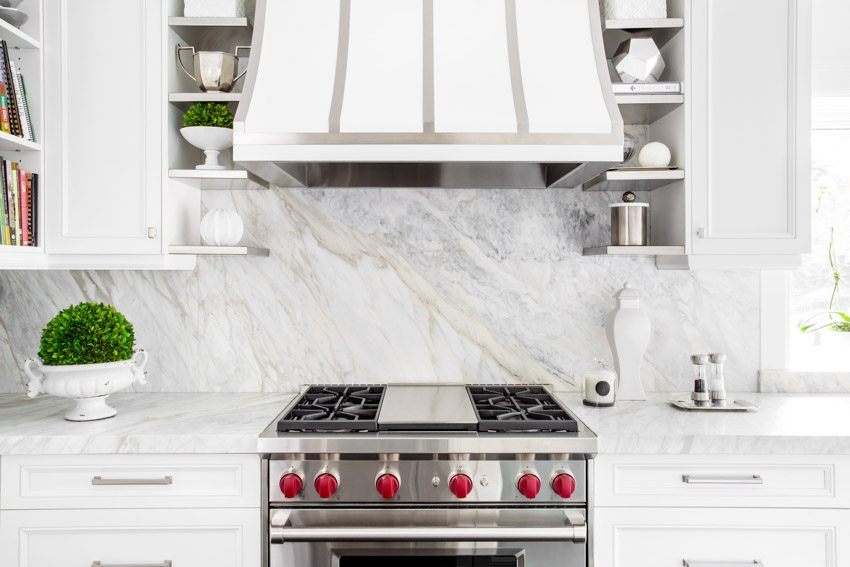
• It’s low maintenance: Understandably, life can be busy, and there will be instances wherein you won’t have the luxury to constantly clean, seal, and maintain your natural stone backsplash.
This is a major benefit of a fired clay slab marble look. It is a solid surface that perfectly mimics the look and feels of marble without all of the tedious maintenance that comes with it.
You can wipe it down with a basic household cleaner and a wet rag, and you’re pretty much good to go. There also isn’t any grout, stains, or chips to worry about, as fired clay is naturally impervious to the basic elements.
It has a seamless design: Sure, backsplash updates in general can take your kitchen aesthetics from drab to fab in an instant, but there’s just something about fired clay slabs that mimic marble that is a little awe-inspiring not just to you but to your guests at home as well.
With the way that it’s installed, it looks seamless and incredibly cohesive and provides a smooth transition from your countertops to your backsplash, all the way up to your kitchen walls and cabinets
This is exactly how it should be in the first place. Grout lines can put a damper on your backsplash aesthetics, but this isn’t something that you have to worry about with a fired clayslab.
It offers a visual focal point: A porcelain slab that looks like marble can instantly attract the attention of the guests or whoever else enters the room.
If you want your backsplash to be the accent wall or the focal point of the kitchen space, then you’ll be able to do that easily with a fired clay slab that mimics the look and feel of marble. It can hold the attention in the room without being overwhelming and over the top.
Porcelain Pros and Cons
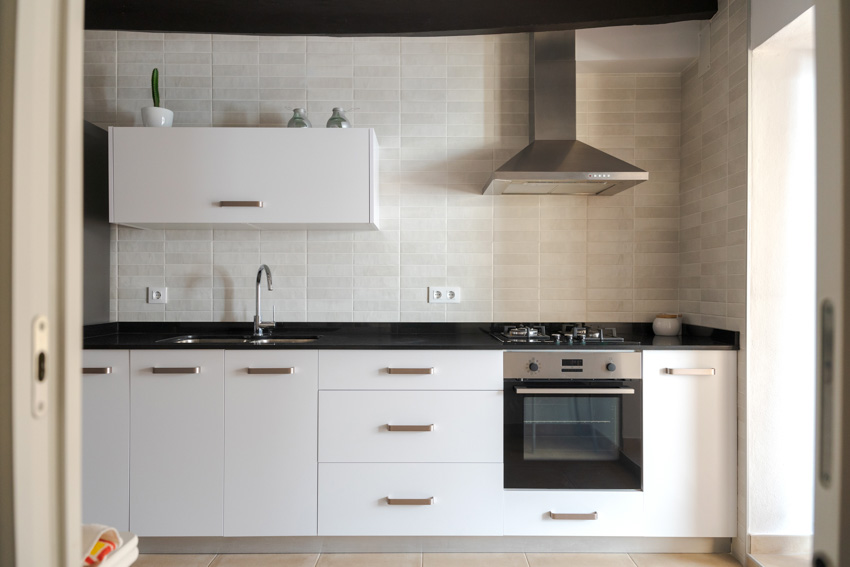
Pros of Porcelain Tile Backsplash
• Lots of design options
• Highly durable
• Stain and water resistant
• Low maintenance
Cons of Porcelain Tile Backsplash
• Comes with a high cost
• Can be slippery, brittle, and heavy
• A little difficult to install
• Has grout that requires sealing
Porcelain Costs
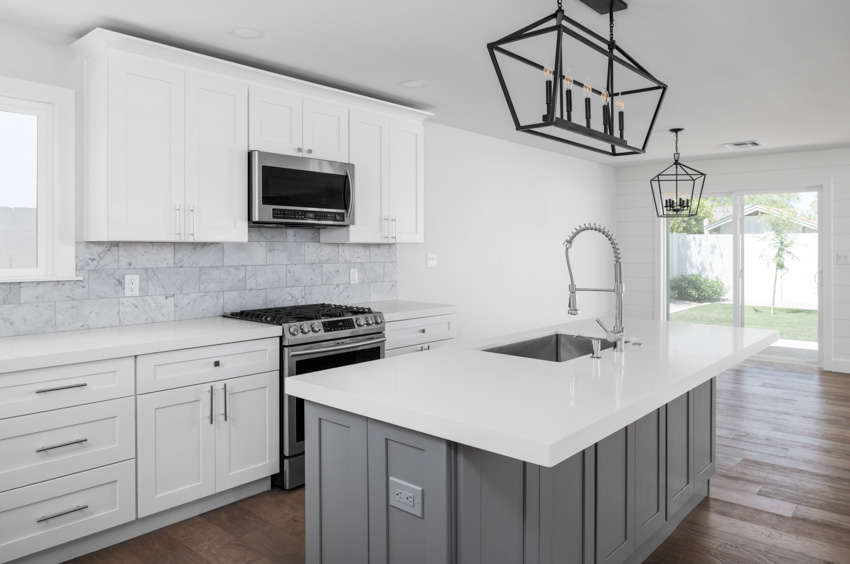
For the raw materials alone, we can comfortably say that fired clay and ceramic tiles are in the same price range. It can be anywhere from $5 to $25 per square foot.
Take note, though, that the law of supply and demand usually applies. So if you purchase in bulk, there’s a good chance that you will get huge bargains, especially from huge home depot stores and the like.
The installation will typically come with its costs, and it may vary greatly depending on the labor costs in your area. A good range would be anywhere from $10 to $25 per square foot.
Although this seems like a huge cost upfront, you need to take note of the fact that high-grade ceramic tiles are long-lasting investments. These tiles will not only increase the resale value of your home but they are also guaranteed to last you for years and years to come as they are highly durable and have prolonged life spans.
Porcelain Slab Backsplash Cost
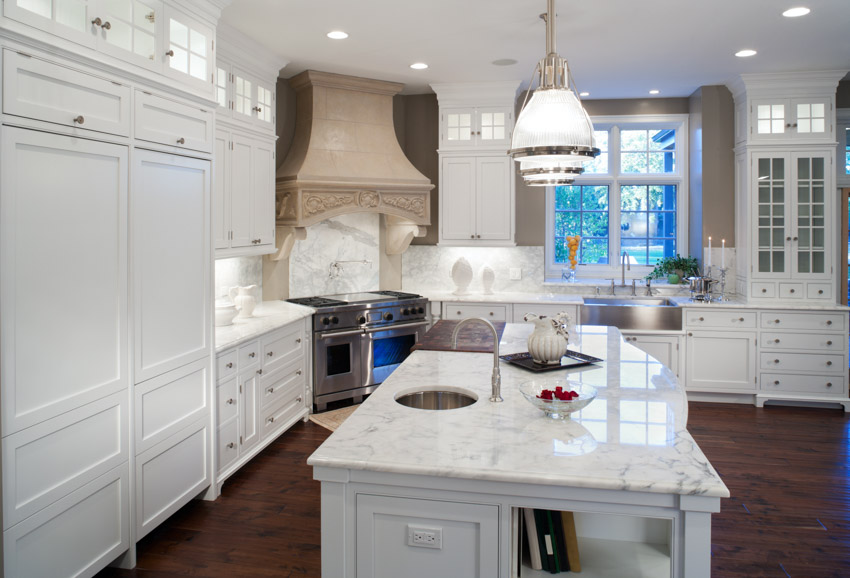
But on average, this should be a good range. In comparison, quartz or granite slabs can range anywhere from $75 to $150 per square foot.
Can You Paint the Porcelain Backsplash
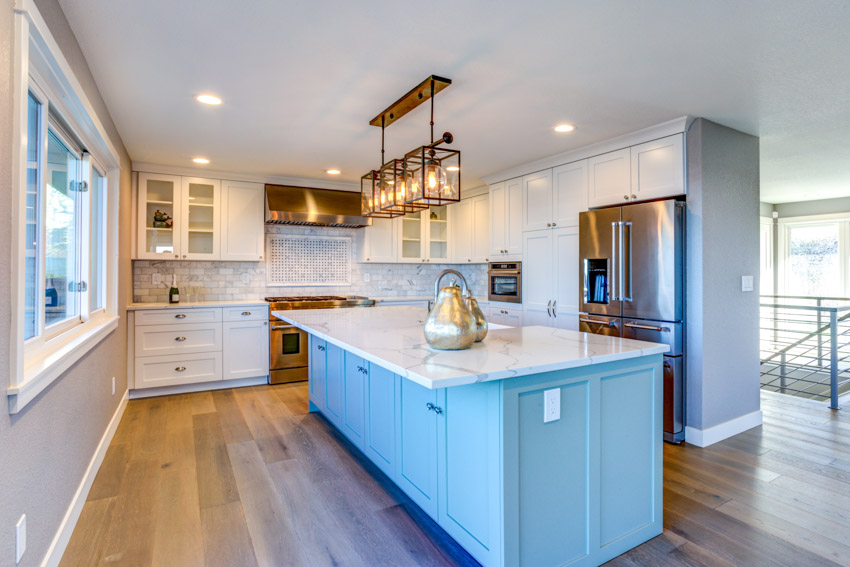
It usually requires tile paints or a special mix of epoxy paints. These types of paints are made to stick to tiles and are known to be washable and extremely durable. A roller is usually required for even application.
Ceramic or Porcelain for the Kitchen Backsplash?
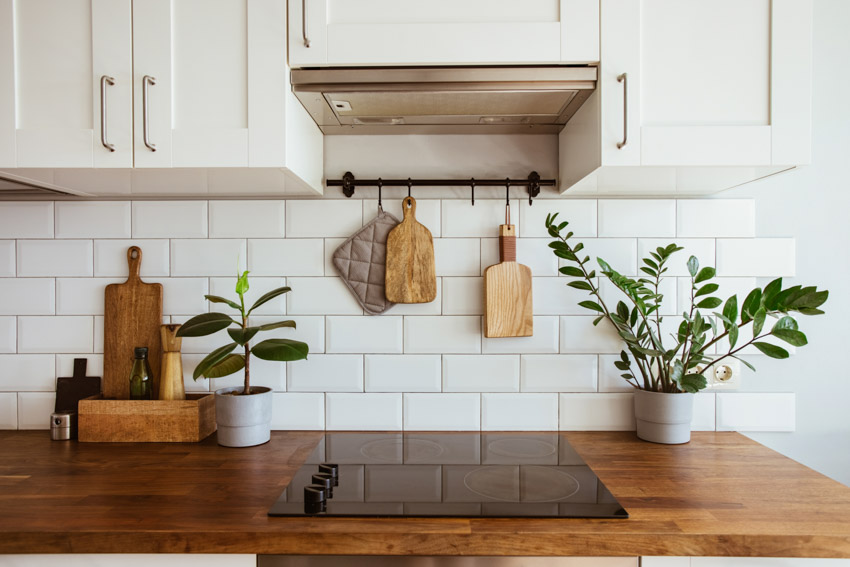
It’s made up of denser particles and has usually been fired up at much higher temperatures, resulting in an end material that’s virtually impervious to staining, etching, chipping, water damage, and so on.
It makes for a perfect kitchen backsplash material. And given the fact that porcelain vs ceramic tiles cost almost the same these days, it makes former the runaway winner as far as material superiority is concerned.
How to Clean Porcelain
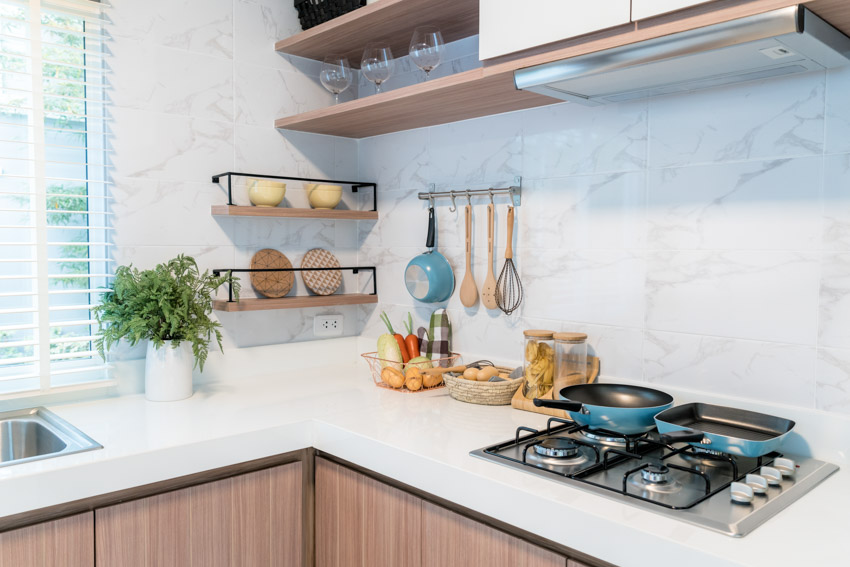
One easy cleaning solution for high-grade ceramic tile backsplash is to mix equal amounts of vinegar and warm water together and add the mixture to a spray bottle. Then you can lightly spray the mixture on the areas needed and wipe clean with a soft damp cloth.
Since backsplashes are in the kitchen and are oftentimes exposed to food, it’s important to keep in mind that you shouldn’t be opting for anything too harsh or toxic, especially if you have kids and pets at home. And besides, it doesn’t require much to keep your fired clay tiles looking clean in the first place.
See more related content in our article about the vertical tile backsplash on this page.

